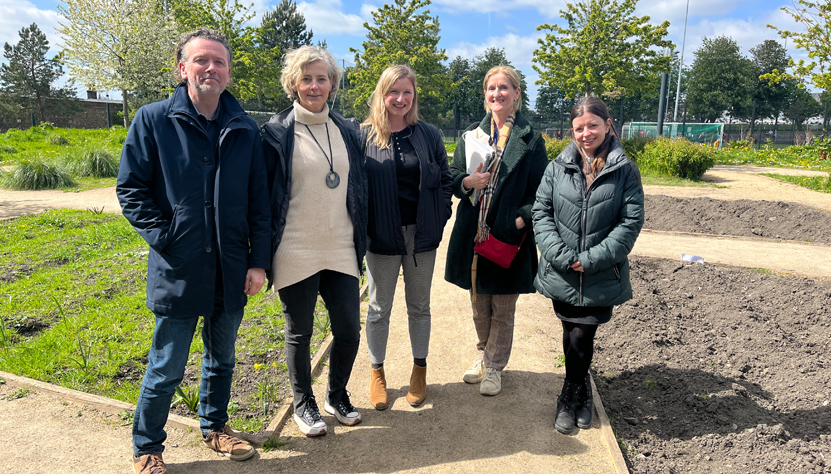Grangegorman Community Garden - Living Lab initiation

Community gardens can take the form of many different types of governance models, depending on their scale, setting, investment and purpose. In Dublin some large community gardens are designed and managed using a top-down approach by property management companies or Local Authorities, and some smaller community garden projects are developed using a bottom-up approach by NGOs or community groups.
That we know of, little experimentation has been made around developing a sustainable governance structure for a community garden with mutual benefit for a multi-stakeholder group on a shared campus site.
The Grangegorman Community Garden is a collaborative garden project engaging stakeholders across all quadrants of the Quadruple Helix Model (QHM) partnering with both academic and service areas within a university, a primary school, a land development agency, and a multi-national organisation, with support from a property estate agent.
A partnership approach
Technological University Dublin, Dublin 7 Educate Together National School (D7 ETNS), the Grangegorman Development Agency (GDA), in addition to the campus’ Smithfield neighbours, Workday have come together to work on this garden project. Each group have a vested interest to enhance the campus environment and provide their people with educational experiences and opportunities to spend time in nature.
The Grangegorman Community Garden Committee was formed at the start of 2024, to restore a previously neglected garden space as part of a year-long pilot project until December 2024.
The purpose of group is to experiment with the development of a sustainable collaborative governance model for a community garden, co-created and trialled by a multi-stakeholder group. The ultimate aim of the Committee and the project is to establish a permanent community garden space with robust investment that can offer continuous support to garden users and welcome a new diverse group of garden users.
Sense making for long-term success
Taking place on 16 January 2024, the first formal gathering of the Committee adopted a sense-making approach to make in-person introductions and to discuss the project’s potential. With the committee formed, collective experiences and mutual interests were heard and understood by the group, and Miro was used to capture sentiment, and record the needs, motivations and capacity iterated by each member.
Key understandings from the sense making activity:
- Together we can build capacity from growing sustainably, using organic, and applying farm-to-fork learning and practice.
- Time to work in the garden and attend committee meetings was expressed as a concern by all members, cooperation and flexibility would be key to keeping people engaged.
- By identifying when groups had availability a garden calendar could be developed to ensure the garden would not be neglected during any period of the growing year.
- Members expressed what knowledge they could bring to the group and highlighted what they needed to learn to help them contribute in a meaningful way.
- National, local, and inter-organisational frameworks, strategies and plans around community, biodiversity, and climate action were discussed. The All-Ireland Pollinator Plan, Dublin City Council’s Climate Action Plan (foundations of foundations – A Resilient City, A Resource-Full City, A Creative City and A Social City), the Grangegorman Masterplan, GDA Biodiversity Strategy and TU Dublin Climate Action Roadmap, Gardening for Biodiversity Education & Training Natural Heritage & Biodiversity (2020), were all considered relevant.
- Members agree to explore opportunities for cooperative partnerships with other groups and networks, including other Grangegorman stakeholders, Community Gardens Ireland, GLAS GAP, Healthy Dublin City, Grangegorman Histories, Cabra Men’s Shed, TU Dublin Tallaght Library Sensory Garden, TU Dublin and Airfield Estate's Botanical Cuisine programme.
- Expert advice was given by members who had worked with different types of community gardens, and the ‘GLAS at TU Dublin’ on the Blanchardstown campus was considered as a guiding model.
- Although the scale and potential for the Grangegorman Community Garden would always be smaller than what has been achieved with the ‘GLAS at TU Dublin’ garden, each stakeholder agreed that an expert gardener role was needed to lead the garden project after the trial.
Following this first meeting, it was agreed that the group needed a second sense-making meeting, in quick succession, to continue the exploration phase.
Shared Impact
This living lab project supports TU Dublin's Strategic Intent to 2030 under the pillars of
- People (fostering individual talents in an ever-changing world),
- Planet (a powerhouse for living & breathing sustainability),
- and Partnership (delivering shared impact).
![]()
![]()
![]()
![]()
![]()
![]()
Community gardens have the power to strengthen communities, and support many of the United Nations (UN) Sustainable Development Goals (SDG). This garden project supports in particular SDG 3: Good Health and Well-being, SDG 4: Quality Education, SDG 11: Sustainable Cities and Communities, SDG 13: Climate Action, SDG 15: Life on Land and SDG 17: Partnerships for the Goals.
